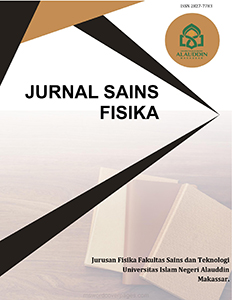ANALYSIS OF TENSILE STRENGTH AND EFFORTLESSNESS OF BIODEGRADABLE PLASTIC WITH THE ADDITION OF TiO2
Abstract
Biodegradable plastic (bioplastic) is a very potential candidate because it is generally biodegradable. Starch-based bioplastics have several advantages, including renewable, biodegradable and easy to process. The aim of this research is to determine the potential of durian seed waste starch with the addition of TiO2 as an environmentally friendly bioplastic. The method used is by measuring thickness, tensile strength testing and creep strength testing. This research resulted in the best material being obtained in samples with a thickness of 0.2 mm, a tensile strength of 22.96 % and an elongation strength of 25.55 %. The results obtained are biodegradable plastic made from Durian seed waste starch with the addition of TiO2 which can be an alternative to plastic. The basic waste materials of course the results obtained in this research are environmentally friendly, safe for health and of course have affordable prices for all levels of society.
Downloads
References
Amiruddin, A. 2020. Utilization of White Teak Sawdust Waste (Gmelina arborea Roxb.) As Biodegradable Plastic. Tesis. Universitas Hasanuddin. 1-60.
Aripin, S., Saing, B., & Kustiyah, E. 2017. Studi Pembuatan Bahan Alternatif Plastik Biodegradable dari Pati Ubi Jalar Dengan Plasticizer Gliserol dengan Metode Melt Intercalation. Jurnal Teknik Mesin, 6(2), 18. https://doi.org/10.22441/jtm.v6i2.1185
Christianty, M., A. 2009. Produksi Biodegradable Plastic Melalui Pencampuran Pati Sagu Termoplastis Dan Compatibilized Linear Low Density Polyethylene. Tesis. Bogor: Institut Pertanian Bogor.1-76.
Gutiérrez, T. J., Seligra, P. G., Jaramillo, C. M., Jaramillo, C. M., Famá, L., & Goyanes, S. 2017. Effect of Filler Properties on the Antioxidant Response of Thermoplastic Starch Composites. In V. K. Thakur, M. K. Thakur, & M. R. Kessler (Eds.), Handbook of Composites from Renewable Materials (1st ed., pp. 337–369). Wiley. https://doi.org/10.1002/9781119441632.ch14.
Maladi, I. 2019. Pembuatan Bioplastik Berbahan Dasar Pati Kulit Singkong (Manihot utilissima) dengan Penguat Selulosa Jerami Padi, Polivinil Alkohol dan Bio-Compatible Zink Oksida. Skripsi. Jakarta: Universitas Islam Negeri Syarif Hidayatullah. 1-82.
Kumar, A. A., Karthick, K., & Arumugam, K. P. 2011. Biodegradable Polymers and Its Applications. International Journal of Bioscience, Biochemistry and Bioinformatics, 173–176. https://doi.org/10.7763/IJBBB.2011.V1.32.
Najih, I. 2019. Sintesis Plastik Biodegradable Berbahan Kitosan, Arang Manggis Dan Minyak Sereh. Skripsi. Semarang: Universitas Islam Negeri Walisongo. 1-56.
Safiah, S. 2023. Plastik Biodegradable Bahan Dasar Pati Singkong (Manihot esculenta) dengan Campuran Selulosa. Jurnal Ilmiah Teknik Unida, 4(1), 113–118. https://doi.org/10.55616/jitu.v4i1.521.
Sari, L. 2013. Pengaruh Nanopartikel Titanium Dioksida Pada Resin Sebagai Material Transparan Anti UV dan Self Cleaning. Jurnal Fisika Unand, 2(1).
Sudarsono, S. 2012. Kajian Sifat Mekanik Material Komposit Propeler Kincir Angin Standard Naca 4415 Modifikasi. Prosiding Seminar Nasional Aplikasi Sains & Teknologi (SNAST) Periode III. A379-A387.
Arifin, U., F. 2022. Pengaruh Tingkat Keasaman Gelatinisasi Pada Sintesis Bioplastik Dari Pati Ketan Berpenguat Serbuk Daun Bambu. Berkala Penelitian Teknologi Kulit, Sepatu, dan Produk Kulit, 21(2), 257–267.
https://doi.org/10.58533/bptkspk.v21i2.179.
Utilization of White Teak Sawdust Waste (Gmelina ArboreaRoxb.) As Biodegradable Plastic. 2020. Advances in Environmental Biology.
https://doi.org/10.22587/aeb.2020.14.3.2.

